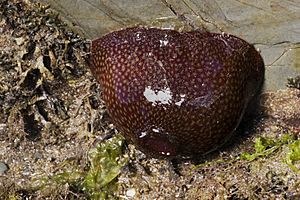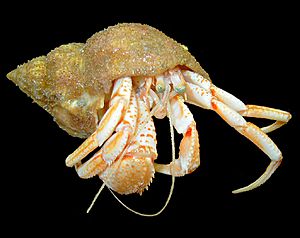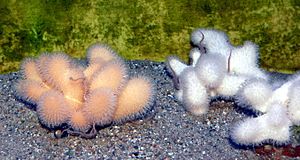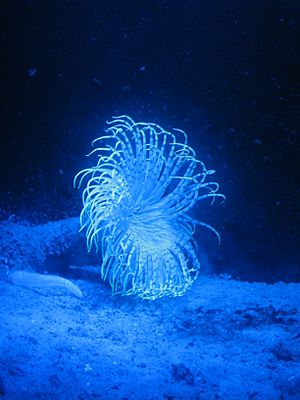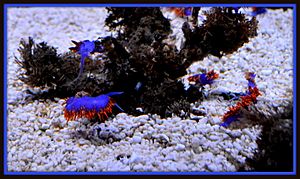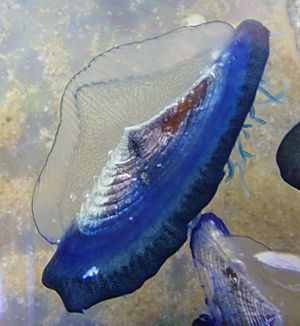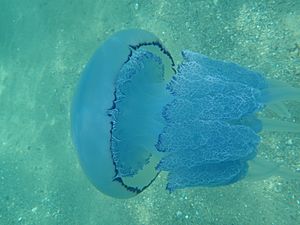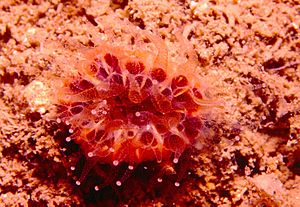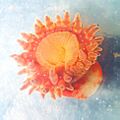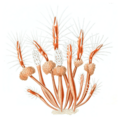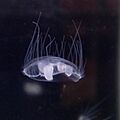List of cnidarians of Ireland facts for kids
Cnidarians are amazing sea creatures, and you can find 302 different kinds living in Ireland and its waters! This group of animals includes well-known creatures like sea jellies (often called "jellyfish"), sea anemones, and corals.
What makes cnidarians special? They all have tiny stinging cells called cnidocytes. They use these cells mainly to catch their food. Imagine a tiny harpoon! Their bodies are quite simple. They have a jelly-like middle layer called mesoglea. This is like the jelly in a sandwich, between two thin skin layers.
Cnidarians come in two main shapes:
- Medusae: These are free-swimming, bell-shaped creatures, like a typical jellyfish.
- Polyps: These are usually attached to something, like a rock. They look like a tube with a mouth and tentacles at the top, just like a sea anemone.
Both shapes have a mouth surrounded by tentacles. These tentacles are covered in those special stinging cells. They also have a body cavity that acts as both a stomach and lungs, helping them digest food and breathe. Many cnidarians live in groups, forming colonies where many individuals work together.
Contents
- Discovering Irish Cnidarians
- Images for kids
Discovering Irish Cnidarians
Ireland's waters are home to many types of cnidarians. Let's explore some of the main groups you might find!
Sea Anemones: Colorful Flower Animals
Sea anemones are beautiful, often brightly colored polyps. They usually attach themselves to rocks or shells. Their tentacles wave in the water, waiting for small prey to swim by.
Common Sea Anemones in Ireland
You can spot many kinds of sea anemones along the Irish coast. Some well-known ones include:
- Actinia equina (beadlet anemone)
- Actinia fragacea (strawberry anemone)
- Anemonia viridis (snakelocks anemone)
- Anthopleura ballii (red speckled anemone)
- Aulactinia verrucosa (gem anemone)
Anemones Living with Crabs
Some anemones have interesting relationships with other animals. For example, the Calliactis parasitica often lives on the shells of crabs. This helps both animals! The anemone gets a ride and new feeding spots, and its stings protect the crab.
Other Fascinating Anemones
- Metridium senile (plumose anemone) is a tall, feathery anemone that can grow quite large.
- Cereus pedunculatus (daisy anemone) looks like a daisy with many petals.
- Sagartia troglodytes (mud sagartia) likes to live in muddy areas.
Soft Corals: Flexible Underwater Gardens
Unlike the hard, stony corals that build reefs, soft corals are flexible. They don't have a hard skeleton. They often look like plants or fingers.
Fingers and Fans
- Alcyonium digitatum (dead man's fingers) is a common soft coral. It looks like a hand with thick, fleshy fingers.
- Alcyonium glomeratum (red sea fingers) and Alcyonium hibernicum (pink sea fingers) are other colorful finger-like corals.
- Eunicella verrucosa (broad sea fan) is a beautiful, fan-shaped coral. It filters food from the water as currents pass by.
Tube-Dwelling Anemones: Hidden Wonders
These anemones live inside a tube they build in the sand or mud. They can pull themselves back into their tubes if they feel threatened.
- Pachycerianthus multiplicatus (firework anemone) is a stunning example, with long, delicate tentacles that look like fireworks.
Hydroids: Tiny Branching Animals
Hydroids often look like tiny plants or feathers attached to rocks or seaweed. But they are actually colonies of many tiny animals! Each tiny animal, or polyp, has a job. Some catch food, others reproduce.
Common Hydroids
- Clava multicornis looks like small pink or red clubs.
- Hydractinia echinata (snail fur) often grows on snail shells.
- Tubularia indivisa (oaten pipes hydroid) has long, tube-like stems.
Freshwater Hydras
Not all cnidarians live in the sea! Two types of hydras, Hydra viridissima (green hydra) and Hydra vulgaris (common hydra), live in freshwater ponds and lakes. They are tiny, simple polyps.
Unique Floating Hydroids
- Velella velella (sea raft or by-the-wind sailor) is a fascinating hydroid. It's a colony that floats on the surface of the ocean, using a small sail-like structure to catch the wind.
True Sea Jellies: The Ocean's Pulsing Wonders
These are the sea jellies most people think of when they hear "jellyfish." They drift through the water, pulsing their bells.
Big and Beautiful Jellies
- Rhizostoma pulmo (barrel jelly) is a very large and common jellyfish in Irish waters. It can be as big as a dustbin lid!
- Cyanea capillata (lion's mane jelly) is one of the largest jellyfish in the world. Its long, flowing tentacles can look like a lion's mane.
- Cyanea lamarckii (blue jelly) is a beautiful blue jellyfish.
Other Common Sea Jellies
- Chrysaora hysoscella (compass jelly) has brown markings on its bell that look like a compass.
- Pelagia noctiluca (mauve stinger) is a smaller, purple jellyfish that can glow in the dark!
- Aurelia aurita (moon jelly) is very common and easy to spot. It has four horseshoe-shaped rings on its bell.
Stony Corals: Building Blocks of the Deep
While Ireland doesn't have tropical coral reefs, it does have stony corals, especially in deeper, colder waters. These corals build hard, calcium carbonate skeletons.
- Caryophyllia smithii (Devonshire cup coral) is a solitary stony coral, meaning it lives alone rather than in a colony.
- Lophelia pertusa and Madrepora oculata (zigzag coral) are important deep-sea corals that can form large, complex structures, creating habitats for many other creatures.
Stalked Jellies: Upside-Down Wonders
Stalked jellies are unique. Instead of floating freely, they attach themselves to seaweed or rocks with a stalk. They look like tiny, upside-down jellyfish.
- Haliclystus auricula (kaleidoscope jelly) is a small, colorful stalked jelly.
Images for kids
-
The Portuguese man-o'-war is a dangerous floating colony.
-
Cyanea capillata (lion's mane jelly) has very long tentacles.
-
Arachnanthus sarsi, a tube-dwelling anemone, photographed off Rathlin Island.
-
Isozoanthus sulcatus in Lough Hyne is a type of zoanthid.


